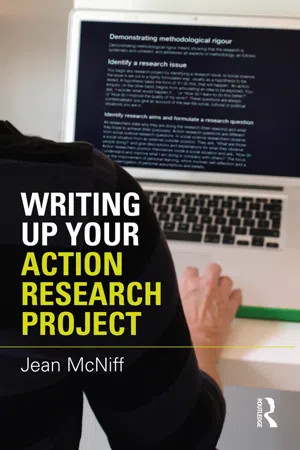
- 206 pages
- English
- ePUB (mobile friendly)
- Available on iOS & Android
Writing Up Your Action Research Project
About This Book
Many practice-based researchers have expert knowledge of doing research but often experience difficulties when writing it up and communicating the significance of what they have done. This book aims to help bridge the gap. Packed with practical advice and strong theoretical resources it takes you through the basics of designing and producing your text so that it will meet established standards and high quality assurance expectations.
Divided into 3 distinctive parts, key points include:
-
- understanding writing practices
- engaging with the literatures
- how to write up a project report or dissertation
- how writing is judged in terms of professional and academic writing practices
- developing ideas for further study and publication
Writing up Your Action Research Project is an essential text for practitioners on professional education and undergraduate courses across disciplines who want their writing to reflect the excellence of their research. It is the ideal companion to the author's You and Your Action Research Project, now in its fourth edition.
Frequently asked questions
Information
Chapter 1 Prologue: what do I need to know about action research? Why do I need to know it?
- what is involved in doing action research;
- how to do action research;
- why you should do action research, and some of the implications involved.
What is Involved in Doing Action Research?
- what action research is, and what it is not;
- some core principles and practices of action research;
- different approaches to action research.
What action research is, and what it is not
What action research is
- ‘action’ refers to what you do in your different contexts, including your personal, social, organisational and political contexts.
- ‘research’ refers to how you find out about what you do in your different contexts, and how you can find ways to do it better.

Taking action
- unintentional action, as when you cough or trip over; this kind of action is often accidental;
- everyday action, such as watching television or doing the washing up, though these can often be undertaken with social intent and become intentional action, as in the next point;
- intentional action, as when you set out to help someone or to improve a service; this kind of action is always purposeful and undertaken to achieve specific goals; this is usually the kind of action you take in action research. (It is worth mentioning here, however, that goals may be destructive and selfish as much as beneficent and other-oriented.)
- personal action, where you act for your personal purposes: you decide to cook a meal or study for a degree;
- social action, where you act in other people’s interests: you advise medical treatments or contribute to solidarity protests against injustices; this then becomes more than action: it becomes or leads into practice, when you act in a coherent and purposeful way for reasons beyond yourself;
- political action, where you act in the world to achieve certain principles and practices: you investigate institutional or corporate practices and ask questions about why things are as they are, where appropriate; this can involve risk to self and requires courage; it then becomes more than practice: it becomes praxis, that is, morally committed, purposeful practice in the world.
Doing research
Doing action research
What action research is not
In this programme of studies I have learned a good deal of things, sharing ideas, socializing, academic writings (my academic paper), the presentation of my findings, a boost in my self esteem and confidence, group discussions, tolerance, listening to other people’s ideas, respect and other meaningful values, and my computer literacy levels have been improved.I can now make a claim that my studies have had a tremendous influence on my practice including my professional development and learning. I felt good about myself after I had made a presentation of my policy proposal and one of my colleagues on the MA in Education course gave me the following critical feedback:‘Your presentation was thought provoking . . . I was excited to realise that your epistemological values were in line with ubuntu. The systematic issues that informed your research should be explored more to influence practice in general and specifically for the Western Cape Education Department.’(Gungqisa, 2008: 7)
Table of contents
- Cover Page
- Half-Title Page
- Title Page
- Copyright Page
- Table of Contents
- List of illustrations
- Acknowledgements
- Introduction
- 1 Prologue: what do I need to know about action research? Why do I need to know it?
- Part I Designing and planning your text
- Part II Writing and producing a text
- Part III Reflecting and evaluating
- References
- Index